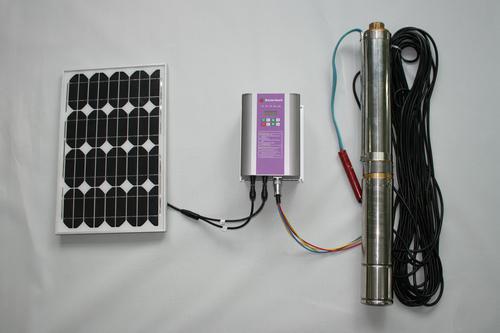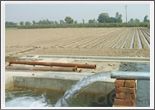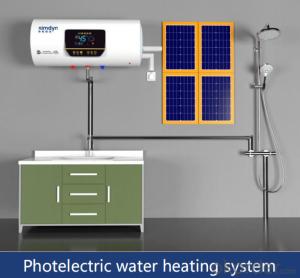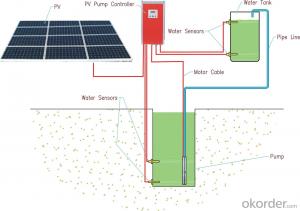PF Solar Pumping Inverter Water Pump Inverter
- Loading Port:
- Shekou
- Payment Terms:
- TT OR LC
- Min Order Qty:
- 20 set
- Supply Capability:
- 500000 set/month
OKorder Service Pledge
OKorder Financial Service
You Might Also Like
Solar Inverter Introduction:
Solar pumping inverter converts DC current from the solar array into AC current to drive the pump. With the function of MPPT (maximum power point tracking), it regulates the output frequency according to irradiation in real time to achieve the maximum power.
Solar Inverters Features:
1. Adopting the proposed dynamic VI maximum power point tracking (MPPT) control method; Fast response and stable operation; Better than the conventional methods which may lead to the problems including poor tracking performances, unstable or even cause water hammer damaging when the irradiation on the array changes rapidly.
2. The solar pumping inverters system is dispensed with energy storing devices, and stores water instead of electricity. It improves the reliability of the device, at the same time, it lowers the construction and maintenance costs of the system dramatically.
3. Digital control; automatic operation and data acquisition/storage of 8 years, etc; 98% of conversion efficiency, and complete protection.
4. In-line blocks; user friendly; convenient for operating; perfect cooling and shielding.
Solar Pumping Inverter Advantages:
1. To drive pumps equipped with 3-phase induction motors.
2. Optimized SPWM.
3. Various operation modes and MPPT algorithms are available.
4. Adjustable speed range of pump based on the actual situation of the system.
5. Available option of water-level detecting and control circuit.
6. Protection functions: lightning, over/low input voltage, over current and over load protection, etc.
7. Enclosure class: IP52.
8. Ambient temperature:-10~+50˚C.
Success Stories
►Middle East ►NaQu ►GuiLin
►Turkey ►XiNing ►YunNan
►Army stationed island ►Bangladesh ►Pakistan
►HaiNan ►HuBei ►Uganda
►XinJiang ►NingXia ►Afghan
►Zimbabwe ►Inner Mongolia ►Zhejiang
►Guangxi Guilin ►Turkey2 ►Botswana
►Naning ►Uganda ►Shaanxi
►Tsinghua University ►Pakistan ►Yunnan2
►FuJian ►Banqladesh ►YunNan3
►Turkey ►Inner Mongolia ►Senegal
- Q: Can a solar controller be used with solar-powered air quality monitoring stations?
- Solar-powered air quality monitoring stations can benefit greatly from the use of a solar controller. This crucial component is responsible for regulating the flow of electricity from the solar panels to the monitoring station, while also preventing the batteries from becoming overcharged. By connecting the solar panels to the station's power system, the solar controller ensures a consistent supply of clean energy to power the various components, including the sensors and data loggers. As a result, these stations can continuously and sustainably monitor air quality without relying on grid power or frequent battery replacements. For optimal performance and reliable operation, it is highly recommended to incorporate a solar controller into solar-powered air quality monitoring stations.
- Q: Can a solar controller be used with different types of solar batteries?
- Yes, a solar controller can be used with different types of solar batteries as long as the voltage and charging parameters are compatible with the specific battery type. However, it is important to ensure that the controller is designed to support the specific chemistry and requirements of the battery to optimize its performance and lifespan.
- Q: Can a solar controller be used with sealed batteries?
- Yes, a solar controller can be used with sealed batteries. In fact, it is recommended to use a solar controller with sealed batteries to regulate the charging process and prevent overcharging, ensuring the longevity and optimal performance of the batteries.
- Q: Can a solar controller handle different load types (e.g., resistive, inductive)?
- No, a solar controller is not designed to handle different load types. It is primarily responsible for regulating the charging and discharging of batteries in a solar power system. The load types, such as resistive or inductive, should be handled by appropriate devices like inverters or converters that are specifically designed for those load types.
- Q: Can a solar controller be used with a solar-powered water pumping system?
- Yes, a solar controller can be used with a solar-powered water pumping system. A solar controller helps regulate and optimize the charging and discharging of the batteries in the system, ensuring efficient power utilization and protection against overcharging or discharging. This is especially important in a water pumping system as it helps maintain a steady flow of water by managing the energy input from the solar panels.
- Q: Can a solar controller be used in a solar-powered marine system?
- Yes, a solar controller can be used in a solar-powered marine system. A solar controller regulates the voltage and current from the solar panels to ensure optimal charging of the batteries. It is a crucial component in any solar-powered system, including marine systems, as it helps protect the batteries from overcharging and maximizes their lifespan.
- Q: Can a solar controller be used with solar string inverters?
- Solar string inverters can be used in conjunction with solar controllers, also known as charge controllers. These controllers are responsible for regulating the charging and discharging of batteries in a solar power system, preventing overcharging and over-discharging and extending battery lifespan. On the other hand, solar string inverters are utilized to convert the direct current (DC) generated by solar panels into alternating current (AC) electricity. This AC electricity can be used to power household appliances or be fed into the grid. Although solar controllers are commonly used in off-grid or hybrid solar systems with battery storage, they can still be employed alongside solar string inverters. In such setups, the solar controller regulates battery charging, while the solar string inverter converts DC electricity from solar panels into AC electricity for immediate use or grid integration. The utilization of a solar controller with solar string inverters offers added control and protection to the battery storage system. This ensures optimal battery charging and safeguards against damage caused by overcharging or deep discharging.
- Q: How does a solar controller handle battery state of charge monitoring?
- A solar controller handles battery state of charge monitoring by continuously measuring the voltage and current flowing into and out of the battery. It monitors the battery voltage to determine its state of charge and uses this information to regulate the charging process. Additionally, some advanced solar controllers also incorporate temperature compensation and algorithms to optimize the charging profile and extend battery life.
- Q: What is the maximum power consumption of a solar controller?
- The maximum power consumption of a solar controller typically depends on the specific model and its features. However, in general, the power consumption of a solar controller is relatively low, usually ranging from a few milliwatts to a few watts.
- Q: Can a solar controller be used in a solar-powered deep-sea mining system?
- Yes, a solar controller can be used in a solar-powered deep-sea mining system. A solar controller is responsible for regulating the power flow from the solar panels to the batteries, ensuring efficient charging and preventing overcharging. In a deep-sea mining system, where solar power may be the primary source of energy, a solar controller would play a crucial role in managing the power supply and maintaining the battery life, making it an essential component.
Send your message to us
PF Solar Pumping Inverter Water Pump Inverter
- Loading Port:
- Shekou
- Payment Terms:
- TT OR LC
- Min Order Qty:
- 20 set
- Supply Capability:
- 500000 set/month
OKorder Service Pledge
OKorder Financial Service
Similar products
Hot products
Hot Searches
Related keywords

































































